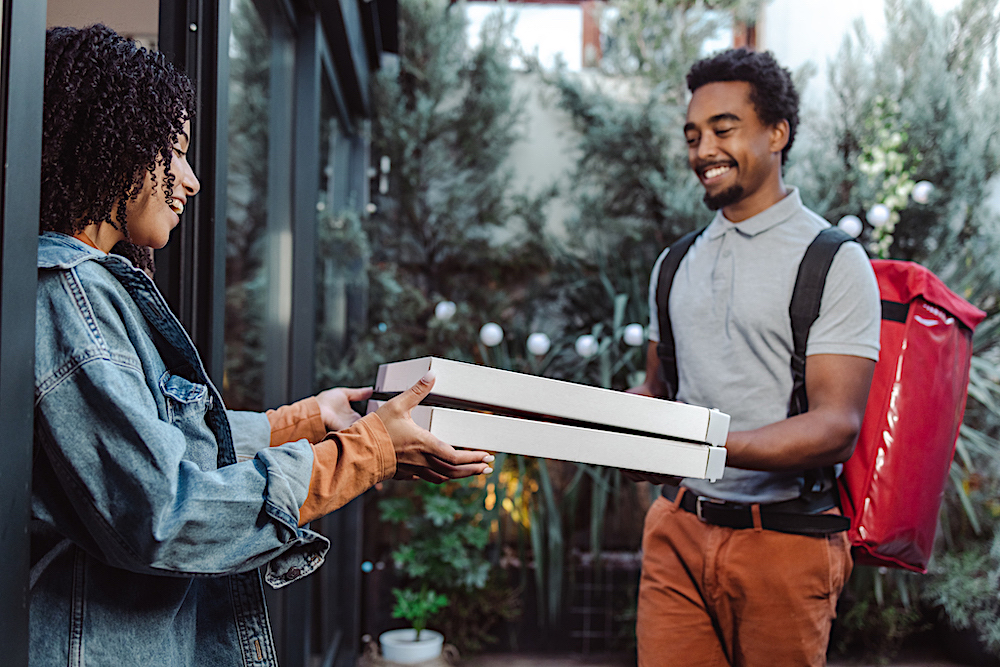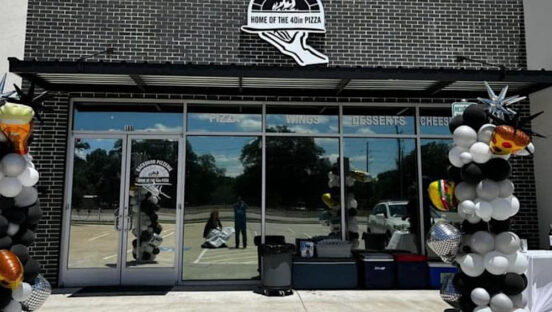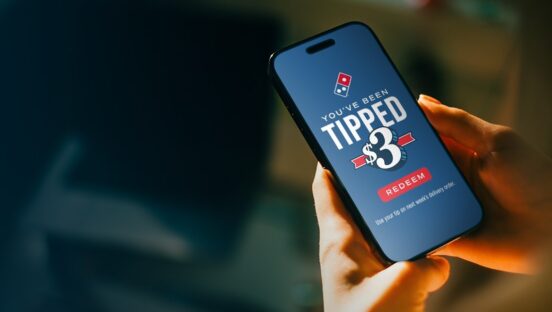By Tracy Morin
Not too long ago, services like DoorDash, Grubhub and Uber Eats were barely a blip on the food delivery radar. In recent years—helped along by everything from technological advancements to COVID-19—third-party delivery has become a go-to service for millions of U.S. customers. This shift has taken place regardless of any disadvantages experienced by operators and customers—and, in fact, the third-party players themselves: New York magazine reported that, in the second quarter of 2020, Uber Eats lost $232 million in the course of its operations.
If you’re tired of relying on third-party services—and think you could do it better in your local area—you might consider starting your own delivery service. That’s what Andrew Simmons, founder of OrangeCrate and owner of Mamma Ramona’s in Ramona, California, did—though he started the delivery service before his pizzeria and recently sold his stake in the former to his partner, in order to focus more on the restaurant.
Related: How independent pizzerias and local restaurant delivery services can join forces
But times have changed since OrangeCrate’s beginnings in 2015, when Simmons was handling deliveries for Domino’s. “I saw a real opportunity for delivery of all restaurants—you could get pizza, but you couldn’t get Thai or Greek delivered,” he recalls. “It was hard to start back then, but today there are so many tools to launch your own delivery service.”

Andrew Simmons
Getting Started
Some of those newer tools are based on old-fashioned people power, while others are on the technology side. For example, Simmons is president of the Restaurant Marketing Delivery Association (RMDA), which boasts a membership of 550-plus locally owned and operated restaurant delivery services in about 700 cities. This organization is a good first stop for a newcomer to this kind of business, even if you’re currently operating a restaurant and know delivery from the foodservice side.
“Join the RMDA and ask their advice on what would work in your market,” Simmons recommends. “They can run a research report to determine the number of restaurants in your area and what services they’re currently using, then share best practices.” He adds that more established members can even help mentor a newbie, so someone starting out can make fewer mistakes along the way.
The second most important component, Simmons says, is the right software—and, luckily, there are now many options. “I recommend Cartwheel delivery software to manage your own suite of drivers—or, if your drivers are not available, you can tap into their driver pool,” he explains. “Choosing a good software is crucial: to market to customers, track where the orders are going, hire drivers—there’s software to manage all of that for you. A company like DeliverLogic can find, recruit, dispatch and pay drivers, while Everee software also helps you pay drivers on time.” Driver-wise, you’ll have to determine if you want W-2 employees or 1099 contract workers.
Related: Flying high: This pizza chain to offer drone delivery in 2024

The Personal Touch
When you’re trying to compete with the big names, like DoorDash, how do you stand out to customers as a better option? Aside from making yourself known as a local alternative—which appeals to customers who want to support their communities—you can also differentiate yourself through better service.
Simmons, working in his own pizzeria, has seen firsthand the difference that can exist between drivers. “Using Cartwheel, I can track where the driver is and can communicate with him; using DoorDash, I have no idea where that driver is and can’t reach him,” Simmons notes. “Also, because I use DoorDash as well, in the last two months, I haven’t seen a single driver show up with a hot bag. But when you work with independent delivery drivers—on-demand, vetted drivers are now available across the U.S. through companies like dlivrd—they show up with bags.”
Another great way to set yourself apart is through embracing an attitude of togetherness. That’s been a driving force for one of RMDA’s members, Lisa Garman, who owns the delivery service Good2Go in Davenport, Iowa. She advises creating a mission statement that’s less about making tons of money and more about helping your own restaurant and others in your area. “The margins on this side are not terribly better than restaurant ownership, so you want to have some kind of mission that’s bigger than yourself,” Garman says. “You need to earn people’s trust in this business, because their reputation rides with you. You want to be able to come to other restaurant owners and say, ‘I’m here to help us both. Your success is my success.’”
For Garman, that approach manifests through a variety of actions: increasing visibility for new and lesser-known local brands, promoting partner restaurants’ in-person events and promotional offers on social media, and helping restaurants develop a catering menu to land those big-spend corporate clients. Additionally, it’s been important to please customers with exceptional service—and take good care of the drivers who are delivering the goods.
Related: Study shows personal touch beats third-party delivery every time
Helpful Hints
Garman suggests starting a delivery service by talking to fellow restaurant owners that you know, before cold-calling. “Know the value of what you’re bringing to people,” she adds. “I recommend against adding restaurants who have said no to your service—some people just slap the restaurant’s menu online with big markups and deliver them anyway. Instead, build a small network first. If a customer comes to me and says, ‘I wish you had X restaurant,’ I tell them, ‘Great—you go there three times a week to eat, tell them!’ You want to work with people who are excited to work with you.”
In addition, it can be a concern for those who have a pizzeria to start delivering others’ food—won’t that detract from your own sales? Thus, you might choose to start out by offering totally different kinds of cuisine. “You could offer delivery not from competitors, but complementary businesses,” Simmons says. “Not everyone wants to buy pizza every day. Customers like options. Plus, with other owners, you can work together on pricing—either setting up a co-op-type delivery service among six or eight restaurants, or starting an independent company that brings on every restaurant, even at the risk of cannibalizing your own sales. A lot of it depends on the city you’re in.”
For example, in some smaller areas, DoorDash might not even be available yet, giving you an immediate edge, while in large cities it might be an insurmountable task to go up against the big guys—unless the restaurants you work with are willing to cut ties with those well-known brands, and you all work to cross-promote. But Simmons admits that few operators are willing to do this, even if they keep more profits by avoiding the larger third-parties.
Finally, to market your delivery services, Simmons recommends starting by reaching out to your existing customer list, then using Facebook or social media ads, SMS/push marketing, or, if it makes sense in your area, direct mailings or door hangers. “You have to touch the customer at least five times to get one order,” Simmons notes. “Then do a great job—great service, great content, and great food choices. OrangeCrate has been around eight years, and we still don’t get most orders. You can hit at every touchpoint, but you don’t have a billion-dollar budget like the big guys.”
SIDEBAR: What Drivers Want
Everee, a payroll technology company, joined with the Restaurant Marketing Delivery Association (RMDA) to create The 2023 Gig Drivers Report, which examines the current state of gig drivers. Some key findings:
- Although the need for gig drivers is increasing, roughly 42% of drivers say it’s possible they will leave gig work within the next 12 months, due to low or unpredictable earnings (30%), lack of benefits (28%), and the rising cost of performing work tasks (27%).
- Nearly 40% of drivers are working less due to high gas prices, while 38% find themselves working more to try to combat the rising costs. When looking at inflation as a whole, 49% are doing more gig work to try and make ends meet.
- Although 68% prefer to remain 1099 contractors, 81% said they’d give up 1099 flexibility for more money, and 77% would become W-2 employees for healthcare benefits.
- 76% live paycheck to paycheck.
- 42% say they’ve declined a gig job because they had to wait too long to get paid, and 45% have removed themselves from a potential gig job because of long onboarding processes.
- 22% say that negative customer interactions remain a top concern, and 19% indicated they might leave gig work due to feeling unsafe while performing job duties.
“With driver satisfaction and retention, one of the immediate fixes is the ability to offer more predictable earnings, fair wages, and instant access to pay,” said RMDA president Andrew Simmons about the report. “Making conscious efforts in order to improve driver engagement can help companies stand out from the pack and compete with the established gig-economy giants like DoorDash and Uber.”













